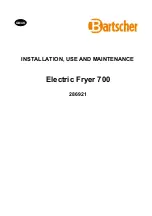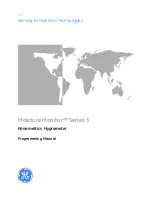
3-14
n
Whirlpool & Maytag 9.2 Cu. Ft. Steam Dryer
COMPONENT TESTING
For Service Technician Use Only
TEST #4a: Thermistors
NOTE:
Refer to strip circuit below to diagnose outlet and inlet
temperature thermistors.
Outlet (Exhaust) Thermistor
The ACU monitors the exhaust temperature using the outlet
thermistor, and cycles the heater relay on and off to maintain
the desired temperature.
NOTE:
Begin with an empty dryer
and a clean lint screen.
1. Unplug dryer or disconnect power.
2. Remove console to access the machine electronics.
3. Remove connector J14 from the ACU and measure the
resistance between J14-3 and J14-6 at the connector. The
following table gives temperatures and their associated
resistance values.
NOTE:
All thermistor resistance measurements must be made
while dryer is unplugged and connector removed from ACU.
OUTLET THERMISTOR RESISTANCE
TEMP
°F (°C)
RES. RANGE
k ohms
TEMP
°F (°C)
RES. RANGE
k ohms
50° (10°)
19.0-22.0
80° (27°)
8.5-10.5
60° (16°)
14.8-16.8
90° (32°)
6.8-8.8
70° (21°)
11.5-13.5
100° (38°)
5.0-7.0
¾
If the resistance is OK, the outlet thermistor is good.
Proceed to step 4.
¾
If the thermistor resistance does not agree with the
table, replace the outlet thermistor.
4. Check J14-3 and J14-6 to dryer cabinet ground. If either
pin indicates continuity to ground (short), replace wiring
harness; otherwise, proceed to step 5.
5. If the preceding steps did not correct the problem, replace
the ACU.
Temperature Levels Incorrect
– If no error code is displayed
and the connections to the thermistor are good, check the
exhaust temperature value at any or all of the temperature
levels in question, using the
Timed Dry
cycle.
IMPORTANT:
Be sure
EcoBoost
(if available) is turned OFF
before testing.
1. Remove load from dryer and disconnect external vent.
2. Plug in dryer or reconnect power.
3. Run a
MIXED +
TIMED DRY
cycle of at least 2 minutes in
duration and select a temperature setting using heat.
4. Using a calibrated temperature probe, take a temperature
measurement in the center of the exhaust outlet. The
correct exhaust temperatures are as follows:
3$*(
FOR SERVICE TECHNICIAN’S USE ONLY
DO NOT REMOVE OR DESTROY
NOTE:
All thermistor resistance measurements
must be made while dryer is unplugged and
connector removed from ACU.
¾
If the resistance is OK, the outlet thermistor
is good. Proceed to step 4.
¾
If the thermistor resistance does not agree
with the table, replace the outlet thermistor.
4.
Check J14-3 and J14-6 to dryer cabinet
ground. If either pin indicates continuity
to ground (short), replace wiring harness;
otherwise, proceed to step 5.
5.
If the preceding steps did not correct the
problem, replace the ACU.
Temperature Levels Incorrect –
If no error code
is displayed and the connections to the thermistor
are good, check the exhaust temperature value
at any or all of the temperature levels in question,
using the
Timed Dry
cycle.
IMPORTANT:
Be sure EcoBoost (if available)
is turned OFF before testing.
1.
Remove load from dryer and disconnect
external vent.
2.
Plug in dryer or reconnect power.
3.
Run a
MIXED + TIMED DRY
cycle of
at least 2 minutes in duration and select a
temperature setting using heat.
4.
Using a calibrated temperature probe,
take a temperature measurement in the center
of the exhaust outlet. The correct exhaust
temperatures are as follows:
¾
If the temperature is not reached within
~7 minutes, check voltage level and vent
blockage, and then retest.
¾
If the temperature probe does not agree
with temperature setting, replace the outlet
thermistor.
TEMP.
°F (°C)
RES.
RANGE
k ohms
TEMP.
°F (°C)
RES.
RANGE
k ohms
50° (10°)
19.0–22.0
80° (27°)
8.5–10.5
60° (16°)
14.8–16.8
90° (32°)
6.8–8.8
70° (21°)
11.5–13.5
100° (38°)
5.0–7.0
OUTLET THERMISTOR RESISTANCE
TEMPERATURE
SETTING
HEAT TURNS OFF*
°F (°C)
HEAT TURNS ON
°F (°C)
155° ± 5° (68° ± 3°)
140° ± 5° (60° ± 3°)
125° ± 5° (52° ± 3°)
105° ± 5° (41° ± 3°)
EXHAUST TEMPERATURES
10–15° (6–8°)
below the
heat turn off
temperature
(appearance may vary)
¾
If the temperature probe confirms the
temperature setting, retest at a different
temperature setting.
5.
If the preceding steps did not correct the
problem, replace the ACU.
Inlet Thermistor
NOTE:
On the electric dryer, the inlet thermistor
is part of the high thermostat assembly
(see figure 10a). On the gas dryer, the inlet
thermistor is located at the drum inlet duct
(see figure 16, page 28).
The ACU monitors the inlet temperature using
the inlet thermistor. The inlet thermistor (along
with the outlet thermistor) is used to detect air
flow, and assists in calculating load size.
1.
Unplug dryer or disconnect power.
2.
Remove console to access the machine
electronics.
3.
Remove connector
J14
from the ACU and
measure the resistance between J14-1 and
J14-2 at the connector. The following tables
(electric & gas) give temperatures and their
associated resistance values.
NOTE:
All thermistor resistance measurements
must be made while dryer is unplugged and
connector removed from ACU.
¾
If the resistance is OK, the inlet thermistor
is good. Proceed to step 4.
¾
If the thermistor resistance does not agree
with the table, replace the inlet thermistor.
TEMP.
°F (°C)
RES.
RANGE
k ohms
TEMP.
°F (°C)
RES.
RANGE
k ohms
68° (20°)
61.2–63.7
131° (55°)
14.5–15.3
77° (25°)
49.0–51.0
140° (60°)
12.1–12.8
86° (30°)
39.5–41.1
149° (65°)
10.2–10.7
95° (35°)
32.0–33.3
158° (70°)
8.5–9.0
104° (40°)
26.1–27.2
167° (75°)
7.2–7.6
113° (45°)
21.4–22.3
176° (80°)
6.1–6.5
122° (50°)
17.6–18.5
ELECT - INLET THERMISTOR RESISTANCE
TEMP.
°F (°C)
RES.
RANGE
k ohms
TEMP.
°F (°C)
RES.
RANGE
k ohms
68° (20°)
57.5–67.6
131° (55°)
14.1–15.6
77° (25°)
46.1–53.8
140° (60°)
11.8–12.9
86° (30°)
37.4–43.1
149° (65°)
9.9–10.8
95° (35°)
30.4–34.7
158° (70°)
8.4–9.0
104° (40°)
24.9–28.2
167° (75°)
7.1–7.6
113° (45°)
20.5–23.0
176° (80°)
6.0–6.4
122° (50°)
16.9–18.9
GAS - INLET THERMISTOR RESISTANCE
¾
If the temperature is not reached within ~7 minutes,
check voltage level and vent blockage, and then retest.
¾
If the temperature probe does not agree with
temperature setting, replace the outlet thermistor.
¾
If the temperature probe confirms the temperature
setting, retest at a different temperature setting.
5. If the preceding steps did not correct the problem, replace
the ACU.
Inlet Thermistor
NOTE:
On the electric dryer, the inlet thermistor is part of the
high thermostat assembly (see figure 1, page 3-13). On the
gas dryer, the inlet thermistor is located at the drum inlet duct
(see figures 1 & 2, page 3-3).
WARNING
Electrical Shock Hazard
Disconnect power before servicing.
Failure to do so can result in death or
electrical shock.
Replace all parts and panels before operating.
3$*(
FOR SERVICE TECHNICIAN’S USE ONLY
DO NOT REMOVE OR DESTROY
STRIP CIRCUITS
MOTOR CIRCUIT
HEATER (ELECTRIC)
HEATER (GAS)
THERMISTORS (INLET/OUTLET)
MOISTURE SENSORS
WATER VALVE CIRCUIT
L1
BK
J9-1
K1
MOTOR RELAY
ACU
DRIVE MOTOR
1/3 HP
MAIN
START
2.7-3.0
Ω
3.3-3.6
Ω
5M
3M
6M
2M
1M
See Heater Circuit
LBU
BU
N.O.
DOOR
SWITCH
W
N
J9-2
CENTRIFUGAL
SWITCH
LBU
THERMAL
FUSE
LBU
4M
JUMPER
L1
ACU
BK
HEATER RELAY 1
K2
K3
HEATER RELAY 2
N.O.
N.O.
COM1
COM2
BK
V
V
HEATER 1
HEATER 2
19.6
Ω
R
R-W
N.C.
HIGH LIMIT
THERMOSTAT
CENTRIFUGAL SWITCH
See
Motor
Circuit
1M
2M
3M
5M
6M
R
L2
THERMAL
CUT-OFF
19.6
Ω
L1
ACU
BK
K2
HEATER RELAY 1
N.O.
50-500
Ω
HIGH LIMIT
THERMOSTAT
CENTRIFUGAL SWITCH
1M
2M
3M
5M
6M
N
COM
R
N.C.
BK
THERMAL
CUT-OFF
R-W
MOV
BK
LBU
FS1
FS2
4
5
1
3
2
1V
IG
IGR
HEATER GAS VALVE
1400 ± 70
Ω
570 ± 28.5
Ω
1300 ± 65
Ω
W
W
W
FLAME
SENSOR
VALVE 1
VALVE 2
IGNITOR
R
R
LBU
See
Motor
Circuit
BU
W
DOOR
SWITCH
BU
ACU
J14-2
50K
Ω
R
J14-3
R-W
R
R-W
10K
Ω
INLET TEMP THERMISTOR
OUTLET TEMP THERMISTOR
J14-1
J14-6
INLET THERMISTOR
OUTLET THERMISTOR
ACU
INLET THERMISTOR RTN
OUTLET THERMISTOR RTN
ACU
J13-1
BK
MOISTURE SENSOR
ACU
MOISTURE SENSOR RTN
MOISTURE SENSOR 1
J13-2
J8-2
CHASSIS GND
Y-R
MOV
MOV
BK
R
G-Y
G-Y
G-Y
CHASSIS GND
L1
N
WATER VALVE
J8-1
K4
VALVE RELAY
510-590
Ω
BK
R
ACU
J8-3
W
Figure 13 - Strip circuits.
THERMISTORS STRIP CIRCUIT
Figure 1 - Thermistors Strip Circuit
















































